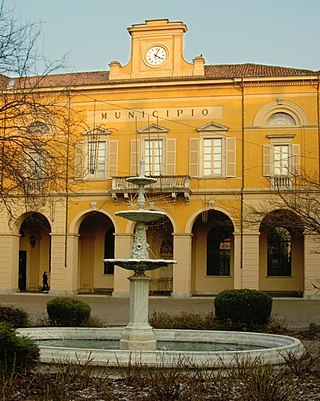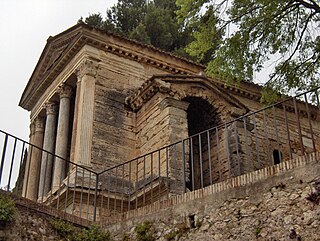
Lombardy is an administrative region of Italy that covers 23,844 km2 (9,206 sq mi); it is located in the northern-central part of the country and has a population of about 10 million people, constituting more than one-sixth of Italy's population. Over a fifth of Italy's gross domestic product (GDP) is produced in the region.

Benevento is a city and comune of Campania, Italy, capital of the province of Benevento, 50 kilometres (31 mi) northeast of Naples. It is situated on a hill 130 metres above sea level at the confluence of the Calore Irpino and the Sabato. In 2020, Benevento has 58,418 inhabitants. It is also the seat of a Catholic archbishop.
Assisi is a town and comune of Italy in the Province of Perugia in the Umbria region, on the western flank of Monte Subasio.

Desiderius, also known as Daufer or Dauferius, was king of the Lombards in northern Italy, ruling from 756 to 774. The Frankish king of renown, Charlemagne, married Desiderius's daughter and subsequently conquered his realm. Desiderius is remembered for this connection to Charlemagne and for being the last Lombard ruler to exercise regional kingship.

The Province of Benevento is a province in the Campania region of Italy. Its capital is the city of Benevento.

Noto is a city and comune in the Province of Syracuse, Sicily, Italy. It is 32 kilometres (20 mi) southwest of the city of Syracuse at the foot of the Iblean Mountains. It lends its name to the surrounding area Val di Noto. In 2002 Noto and its church were declared a UNESCO World Heritage Site.

Spoleto is an ancient city in the Italian province of Perugia in east-central Umbria on a foothill of the Apennines. It is 20 km (12 mi) S. of Trevi, 29 km (18 mi) N. of Terni, 63 km (39 mi) SE of Perugia; 212 km (132 mi) SE of Florence; and 126 km (78 mi) N of Rome.

The Sanctuary of Saint Michael the Archangel is a Roman Catholic shrine on Mount Gargano, Italy, part of the commune of Monte Sant'Angelo, in the province of Foggia, northern Apulia. It has the dignity of a minor basilica.

Mortara is a comune in the Province of Pavia, region of Lombardy, Italy. It lies between the Agogna and Terdoppio rivers, in the historical district known as Lomellina, a rice-growing agricultural center. It received the honorary title of city with a royal decree in 1706.

One of the first streams of Romanesque architecture in Europe from the 10th century and the beginning of 11th century is called First Romanesque or Lombard Romanesque. It took place in the region of Lombardy and spread into Catalonia and into the south of France. Its principal decoration for the exterior, bands of ornamental blind arches are called Lombard bands. It was characterized by thick walls and lack of sculpture in facades, and with interiors profusely painted with frescoes.

Castelseprio was the site of a Roman fort in antiquity, and a significant Lombard town in the early Middle Ages, before being destroyed and abandoned in 1287. It is today preserved as an archaeological park in the modern comune of Castelseprio, near the modern village of the same name. It is in the north of Italy, in the Province of Varese, about 50 km northwest of Milan.

San Salvatore is a former monastery in Brescia, Lombardy, northern Italy, now turned into a museum. The monastic complex is famous for the diversity of its architecture which includes Roman remains and significant pre-Romanesque, Romanesque and Renaissance buildings.

The so-called Temple of Clitumnus is a small early medieval church that sits along the banks of the Clitunno river in the town of Pissignano near Campello sul Clitunno, Umbria, Italy. In 2011, it became a UNESCO World Heritage Site as part of a group of seven such sites that mark the presence of Longobards in Italy: Places of Power.

Lombard architecture refers to the architecture of the Kingdom of the Lombards, which lasted from 568 to 774 and which was commissioned by Lombard kings and dukes.

Santa Sofia is a Roman Catholic church in the town of Benevento, in the region of Campania, in southern Italy; founded in the late-8th century, it retains many elements of its original Lombard architecture.

Longobards in Italy: Places of Power is seven groups of historic buildings that reflect the achievements of the Germanic tribe of the Lombards, who settled in Italy during the sixth century and established a Lombard Kingdom which ended in 774 A.D.

Brescia is a city and comune in the region of Lombardy, in Italy. It is situated at the foot of the Alps, a few kilometers from the lakes Garda and Iseo. With a population of more than 200,000, it is the second largest city in the administrative region and the fourth largest in northwest Italy. The urban area of Brescia extends beyond the administrative city limits and has a population of 672,822, while over 1.5 million people live in its metropolitan area. The city is the administrative capital of the Province of Brescia, one of the largest in Italy, with over 1,200,000 inhabitants.

Torba Abbey, otherwise Torba Monastery is a former Benedictine nunnery in Torba, a frazione of Gornate Olona, Lombardy, Italy, in the Castelseprio Archaeological Park. The buildings are part of a list of structures associated with "Longobards in Italy, Places of Power ", that is dating to the Lombard era of the early middle ages. The abbey was entered on the UNESCO List of World Heritage Sites in June 2011.

The Oratorio di Santa Maria, or Oratory of Santa Maria, previously called the Tempietto longobardo, is located in Valle on the north-eastern frontier at Cividale del Friuli in the province of Udine. It was erected in the 8th century under the rule of a Germanic people called the Lombards who ruled most of the Italian Peninsula from 568 to 774. This is the most important and best preserved example of Lombard architecture, which resembles styles found in Ottonian, Roman, Lombardy and Carolingian art. Included within the temple and chapel are decorated frescoes and high relief sculptures of saints in stucco.
























